Barrett Moving Forward With Streetcar
If Common Council approves at December 16 meeting, construction would start in late 2015, and Milwaukee would follow in footsteps of many other cities.
Mayor Tom Barrett is moving forward with the Milwaukee Streetcar, despite the long standing opposition by state Republicans, We Energies and announced mayoral opponent, Ald. Bob Donovan. The project will be debated on the Common Council floor during the December 16th meeting, and should it be approved, the project will enter the final engineering phase and begin construction in late 2015. A late 2015 construction start would have the full system operational in 2018. The move is an unusually bold showing by Barrett in that he’s not going to wait for the court system to decide whether the city must pay the costs of relocating some utility lines, but its a transportation and economic development project he’s been championing for nearly ten years.
It’s not likely the mayor will find a better time to move forward with the project. The growth of Downtown is an increasingly popular topic of discussion, with Northwestern Mutual building the biggest office building in the state, Irgens building the 17-story, 833 East office tower just blocks away, the potential The Couture apartment tower (with a streetcar stop inside) still in planning, numerous residential high rises proposed along the route (including 700 E. Kilbourn and a new Mandel project at Prospect and Ogden) and perhaps most prominent, a new arena for the Milwaukee Bucks that’s getting endless discussion. Moving the streetcar forward for a final vote will take advantage of all this momentum, and the mayor clearly hopes, build on that progress.
In a statement issued today Mayor Barrett said “Milwaukee residents and businesses have demanded a transportation alternative to spur development and provide more options, something most other cities our size are building or already operating. This starter system will — with future additions to other neighborhoods being planned — provide a modern, attractive way to get around Milwaukee, to and from residences, businesses, cultural institutions and entertainment destinations.”
Barrett is citing the $2.6 billion in downtown development since 2005, with an additional $980 million under construction and $1.3 billion proposed as a “strong sign that Milwaukee needs and can support a streetcar.” Barrett hopes the streetcar can significantly increase those numbers, given the experience in other cities showing fixed route transportation attracts development.
Many in the real estate community are encouraged by the prospects of a fixed rail system in downtown, with developer Barry Mandel of the Mandel Group declaring “the timing for the streetcar is perfect on so many levels. With significant new development including housing coming on line, the streetcar will be a huge benefit to residents, employees and visitors. As in other progressive cities that have leaped into the 21st century, the streetcar will attract significant new investment near the route and help bring new development and jobs into downtown, Milwaukee neighborhoods and, eventually, the region.”
Project Financing and Legal Challenges
Tax-incremental financing works by borrowing against a future increase in property tax revenues to finance improvements to a designated district. TIF districts are used to help support numerous development projects, from the new Northwestern Mutual Tower to the Park East Freeway demolition and road reconstruction to brownfield remediation in the Menomonee Valley. Once the bonds have been paid off property taxes flow back in normal fashion to the local property tax levying bodies (city, county, MATC and MPS). The city has numerous successes with TIF districts under its belt, including the Beer Line B neighborhood, the Menomonee Valley and Third Ward riverwalk. Those districts alone have added hundreds of millions of assessed value to the city’s books and will return millions annually to the city budget.
In addition to the Cathedral Place TIF district, the city intends to use funds from an existing TIF district in the Third Ward and a previously announced lakefront TIF district that would finance public improvements in and around The Couture. The lakefront area TIF would provide $31 million for the streetcar, including stops near the under-construction 833 East office tower, US Bank Center and a couple acres of soon-to-be-developable land opened up by the Interstate 794 ramp reconfiguration.
The city on Monday filed an appeal in Milwaukee County Circuit Court to a ruling by the state’s Public Service Commission that requires the city to pay all the utility costs. The city is arguing the PSC does not have the authority to override the already approved streetcar system. The city is also protesting the state law (passed in the last budget), arguing it violates the constitution’s equal protection clause. Utilities are otherwise required to bear the costs of relocating their lines, as they have for road projects both big and small, from the Marquette Interchange and Zoo Interchange to local street rebuilds.
The fight between the city, state and utilities has been making its way through various legal bodies for more than two years. The city had previously been waiting for the resolution of the case to move forward with the streetcar project, but will instead move forward while the ruling is being appealed. Following the 2011 Common Council vote, the route was projected to begin operation in 2014, but once the legal challenges began from non-city residents, the project was delayed.
Approval Process
The project approval process will require numerous bodies to sign-off on the project before construction can begin. The proposed TIF districts are scheduled to be voted on at a regularly scheduled meeting of the Redevelopment Authority of the City of Milwaukee on December 2nd. Following that, the whole Common Council will take up the project in a floor debate on December 16th during their regularly scheduled meeting. The lakefront leg of the route requires the The Couture to replace the Downtown Transit Center, which requires county approval. At their latest meeting, the Milwaukee County Board of Supervisors held the proposal to sell the Downtown Transit Center to Rick Barrett and Tan Lo of Barrett Visionary Development (no relation to the mayor), and will need to take up the proposal again to allow that leg to move forward. The Common Council vote is by far the most pivotal and will likely dictate the project’s fate.
Project History
The project was originally to be financed with $64.6 million in federal and local funds. An 80/20 federal/local split would have leveraged federal funds first awarded to the city in 1991 to build a regional transit system. Numerous political deals have reduced that original $289 million to $54.9 million today, including funds for new buses for MCTS, removing the Park East Freeway spur, rebuilding the Marquette Interchange and replacing the 6th Street Viaduct with two bridges. The streetcar project itself has gone through numerous iterations, with former Mayor John Norquist proposing to build bus-only lanes on Interstate 94 and a light rail system to Waukesha County (both killed by regional politics), the Common Council proposing to build a electric bus system in 2006 (vetoed by the mayor) and Mayor Barrett originally proposing a downtown streetcar loop in 2007.
The current route was proposed in 2009 by the mayor, with minor modifications made since to avoid key utility intersections (such as the intersection of N. Broadway and E. Mason St.). The Common Council on a 10-5 vote approved the project on July 26, 2011, allowing the project to move from 30 percent to 60 percent engineering completion before it would need to come back for final approval. That final approval is what Mayor Barrett is now seeking.
Private Support
The private sector is increasingly visible on supporting the streetcar. In a press release issued by the Mayor’s office, Mandel threw his support behind the project. Two months ago, when The Couture update was announced to include a new leg on the streetcar system, developer Rick Barrett also announced his support of the project. Wangard Partners has championed the project with their new Avenir apartments about to open based partly on the potential impact of the streetcar. Newcomers to the Milwaukee market have also jumped on board, including Carroll Properties, which intends to build a 36-story tower on the route.
Mayoral Race Impact and Common Council Debate
The fact that two aldermen are running for mayor isn’t likely to be a big factor in the final vote, but look for it to be an issue that aldermen Joe Davis and Bob Donovan will attempt to use in seeking campaign donations. Donovan has long opposed the project, going so far as to issue multiple press conferences denouncing the project. Davis hasn’t been as vocal in his opposition. If there is a significant jobs and jobs training component to the project, it will be hard for him to say no. At one time Davis had even proposed the city issue $200 million in bonds to build a city-wide light rail system and most recently proposed $100 million in bonds to pay for a new arena.
Streetcar support within the council is led by aldermen Robert Bauman and Nik Kovac. They’ll have their work cut out for them to round-up the eight required votes, but history is on their side. The project was moved to its current preliminary engineering stage on July 16th, 2011 with a 10 to 5 vote on the council. Two members who voted in favor of the project have since left the council, alderman Jim Witkowiak (who was replaced by Jose Perez who is believed to support the project) and council president Willie Hines, Jr. Hines was replaced by Russell Stamper and it’s unclear where he stands on the project. Voting against moving the project forward in 2011 were aldermen Jim Bohl, Davis, Donovan, Joe Dudzik, and Michael Murphy (now council president). A handful of the no votes at that point were issued because of the surprise announcement just days before by We Energies, AT&T and other utilities of an estimated $70 million in utility relocation costs. Engineering work on the project has reduced that estimate to a high end of some $25 million today and as low as $10 million.
Route Extensions
Finding additional funds for extending the route will certainly be easier than building the starter system itself. It’s likely the Milwaukee Bucks arena discussion will dictate how the route will traverse Westown, and might even provide funds to extend the route north. At the northeastern end of the route, a proposed high rise by the Mandel Group could be supported with a TIF district, which would allow for partial financing of a route extension towards E. Brady St.
Streetcars Elsewhere
Following the rebirth of the American streetcar in Seattle and Portland, numerous cities have streetcar projects in various states of completion. Cincinnati has a highly controversial project under construction, Atlanta has a starter system undergoing final testing, Tucson has a system that just began operating, Washington D.C. has a system under construction, Seattle has another line serving an entirely new area under construction, Kansas City has a system under construction, and Detroit is underway on a streetcar-light rail hybrid system. All of those systems will likely be in operation before the Milwaukee Streetcar’s planned 2018 start.
Streetcar Route
The proposed route would have the system run from N. 4th St. and W. St. Paul Ave. through the Third Ward to N. Broadway and N. Milwaukee St. where a directional split would occur as the route turns north towards E. Wells St. At E. Wells St. the two tracks would both be on the street, before splitting again at N. Jackson St. and N. Van Buren St. The route is proposed to again run both directions down E. Ogden Ave. to the intersection with N. Farwell Ave.
The lakefront leg, which would also be built with the final approval, would have the system split east down E. Michigan St. to N. Lincoln Memorial Dr. and then come back west on E. Clybourn Ave.
Provided final approval is granted, engineering work would also be done for the system to be extended up N. 4th St. turning W. Juneau Ave heading into The Brewery. In addition, an extension to E. Royall Pl. just north of E. Brady St. between N. Farwell and N. Prospect avenues will be studied. The engineering work will leave these extensions in a shovel-ready state should future funds be available. Additional extensions would require further study.
According to data from the city, the initial route would be within a quarter mile of 100 percent of downtown hotels, 90 percent of occupied office space, 90 percent of occupied retail space, 77 percent of parking stalls, 77 percent of downtown housing units, 90 percent of major downtown attractions, and 100 percent of downtown’s 20 largest employers.
Milwaukee Streetcar Renderings
Urban Milwaukee Streetcar Coverage
- Who Will Be Streetcar Operator – Michael Horne – May 8th, 2014
- A Streetcar Named Cooperation? – Dave Reid – April 27th, 2014
- How a Streetcar Spurs Development – Angie Schmitt – November 3rd, 2013
- Streetcar Social – Michael Horne – September 12th, 2013
- Mayor Says Streetcar is a “Trojan Horse” – Michael Horne – April 17th, 2013
- Whoops, We Changed Our Mind – Dave Reid – September 27th, 2012
- Battle of the Bobs: Donovan vs Bauman Streetcar Press Conference – Jeramey Jannene – May 18th, 2012
- Important Hoan Bridge and Milwaukee Streetcar Meetings This Week – Dave Reid – November 14th, 2011
- Milwaukee Streetcar Passes Common Council – Jeramey Jannene – July 26th, 2011
- Keep the Milwaukee Streetcar Moving Forward – Jeramey Jannene – July 8th, 2011
- Milwaukee Streetcar at Apex – Jeramey Jannene – June 16th, 2011
- Milwaukee Streetcar Takes Key Step Forward – Jeramey Jannene – May 6th, 2010
- Milwaukee Streetcar Meeting This Thursday – Jeramey Jannene – October 5th, 2009
- Milwaukee Streetcar Routes Unveiled by Mayor Barrett – Jeramey Jannene – September 21st, 2009
- Milwaukee Streetcar Round-Up – Jeramey Jannene – April 19th, 2009
- Vote for your Favorite Milwaukee Streetcar Route – Jeramey Jannene – March 25th, 2009
- Design Your Own Streetcar Route – Jeramey Jannene – March 23rd 2009
- Streetcars Coming to Milwaukee – Dave Reid – March 14th, 2009
More about the Milwaukee Streetcar
For more project details, including the project timeline, financing, route and possible extensions, see our extensive past coverage.
- Another Streetcar Collision - Jeramey Jannene - Jun 27th, 2025
- Streetcar Hit By Apparent Red Light Runner - Jeramey Jannene - Jun 16th, 2025
- Streetcar Will Run On Consolidated Route During Summerfest - Jeramey Jannene - Jun 11th, 2025
- City Hall: Milwaukee Must Replace Failing Streetcar Switches - Jeramey Jannene - Feb 24th, 2025
- Streetcar Confronts Limited Funding, Operations Challenges - Evan Casey - Jan 22nd, 2025
- Council Kills Streetcar’s ‘Festivals Line’ - Jeramey Jannene - Jul 31st, 2024
- Streetcar Will Use Festivals-Oriented Route Through Summer - Jeramey Jannene - Jul 9th, 2024
- The Hop’s Lines Will Merge For Easier Summerfest Service - Jeramey Jannene - May 30th, 2024
- Streetcar Begins Daily Service To The Couture, BRT Will Soon Follow - Jeramey Jannene - Apr 11th, 2024
- Milwaukee’s Three Streetcar Extensions Need Mayoral Direction - Jeramey Jannene - Nov 8th, 2023
Read more about Milwaukee Streetcar here
Political Contributions Tracker
Displaying political contributions between people mentioned in this story. Learn more.
- December 1, 2020 - Tom Barrett received $500 from Barry Mandel
- May 14, 2019 - Nik Kovac received $300 from Barry Mandel
- December 27, 2018 - Tom Barrett received $1,000 from Rick Barrett
- December 13, 2017 - Tom Barrett received $1,500 from Rick Barrett
- April 12, 2016 - Michael Murphy received $400 from Barry Mandel
- February 26, 2016 - Russell W. Stamper, II received $794 from Tan Lo
- December 24, 2015 - Michael Murphy received $300 from Jim Witkowiak
- November 2, 2015 - Tom Barrett received $2,600 from Rick Barrett
- March 14, 2015 - Robert Bauman received $150 from Barry Mandel
- September 11, 2014 - Robert Bauman received $386 from Tan Lo
Eyes on Milwaukee
-
Church, Cupid Partner On Affordable Housing
 Dec 4th, 2023 by Jeramey Jannene
Dec 4th, 2023 by Jeramey Jannene
-
Downtown Building Sells For Nearly Twice Its Assessed Value
 Nov 12th, 2023 by Jeramey Jannene
Nov 12th, 2023 by Jeramey Jannene
-
Immigration Office Moving To 310W Building
 Oct 25th, 2023 by Jeramey Jannene
Oct 25th, 2023 by Jeramey Jannene


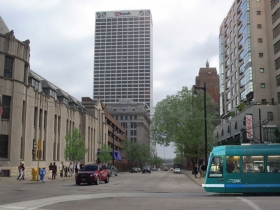
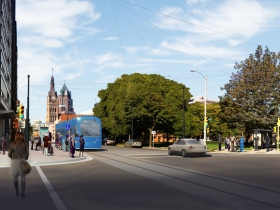
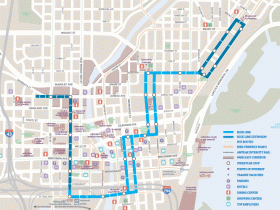
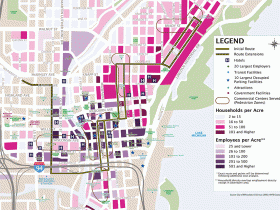
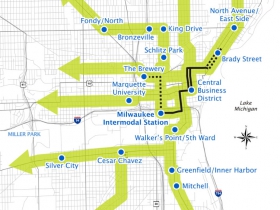
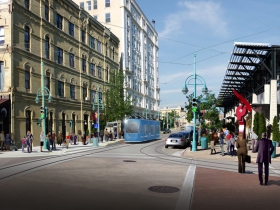
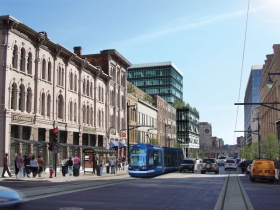




















You’re not going to believe this, but I’m starting to get anti streetcar. Unless this is a true light rail system that goes out to UWM, the airport, etc… then the main thing it’s going to be is a lot of money and a lot of incurred wrath – not only by the goon squad, but by lots of ordinary people too.
Use the “rail only” money on KRM which would be far more cost effective and then spend money on BRT, creative bus systems, and more bike lanes and bike shares. I genuinely think the latter would be better for urbanism than the streetcar.
But what I’m really afraid is that this will embolden the goon squad to the point where other, more important projects, like the Bucks arena will get de-railed.
This is great news. This type of progress will change the city motto from ‘Good Enough’ to ‘Make no small plans’ !!
Its funny because when we propose an incerase in school funding, the goon squad says why do you keep throwing money at your terrible schools. When the city then says lets invest in our transit infrastructure, the goon squad says you have terrible schools, where are your priorities? Invest that money in schools. When we implement a rubber tired trolley system (Lake and River routes) like the one we implemented in 2000, the goon squad says this is a waste of money, get rid of it (which the County did due to political pressure). Then we propose a light rail system, the goon squad says why don’t you implement a more cost effective rubber tire trolly route.
The bottom line is that the goon squad will oppose the city no matter what. Its a political strategy that the have embraced. I remember the KRM, high speed rail, the Northwest Corridor project, etc, and on and on. They are killed because Republicans are philosophically opposed to public transportation. They see it as social engineering and an attack on the individual. They are going to oppose everything. It will not matter how effective or needed the projects are. Of course a double decker $1 billion interchage is needed. Make it a triple decker freeway! They won’t bat an eye. I do know one thing for sure, once built, those against the streetcar now, will be clamoring for an extension to their neighborhood.
Thanks Jeremey for the nice write up on the Milwaukee streetcar project. Unlike the other transit projects that have fallen by the wayside I think this project is on track and we will be riding streetcars in Milwaukee in 2018. It will provide Milwaukee residents and visitors a badly needed transportation option, attract more young people and entrepreneurs to the Third Ward and emerging development areas, and lower the carbon footprint at a time of global climate crisis. When it comes to transit we need to take an all of the above approach.
You are spot on in saying the route alignment needs to match up with the site of the proposed Buck’s arena as the facility will be a significant traffic generator for the starter light rail line. It’s not too soon to move ahead with planning to extend the line up the densely populated east side to the UWM campus.
You state that the private sector supports the light rail project. It would be great if a local private foundation could step forward to help finance the emerging Milwaukee streetcar system. This was done in Detroit with a $35 million grant from the Kresge Foundation to the City of Detroit for construction of the Woodward Avenue streetcar line, for which construction began in July 2014.
Milwaukee has talked about the idea of a streetcar network since the time I was a college student, with studies by SEWRPC, etc. and it is great to see this plan about to turn into an actual operating system!
I’m on board with the streetcar project, mainly for reasons already stated. I’m curious if the current plans include an enhancements to the walkability of the primary areas served by the proposed streetcar lines. I’m a big fan of Jeff Speck’s book Walkable City. One of the main points he makes is that it isn’t enough to just build light rail or streetcars or whatever. There also has to be attractions, places people want to go (he uses Dallas as an example of a city with a great public transportation system that no one uses because there’s a lack of attractions near system stops and a lack of walkable neighborhoods near the stops). I’m not worried about the attractions. There’s plenty of those downtown, in the Third Ward, along the lakefront. But what about the walkability of those areas? Already good enough? What do people think about that aspect?
I’m generally a supporter of the street car… but only if done right. I have 3 main concerns.
1. Who is using the starter system. This is sort of related to PMD’s point about attractions. In my case though, not so much about the walkability… but who is using the system to get to these attractions? You don’t just need a destination, you need a starting point. Without the initial extension up to Royall, the initial route hits on very few completed dense blocks of residential. Is someone driving downtown to a parking lot and then hopping on the streetcar?
2. Why isn’t the starter system a loop? Future extensions would tie in well with a central loop to all downtown destinations and then you can transfer to a different extension if the need arises.
3. I’m not sure I’m a fan of usurping other TIF districts funds and/or creating TIF’s in places that are already seeing development. There’s a lot of things going up regardless of the streetcar that otherwise would be directly bolstering our general funds. Now we’re taking those funds and putting them into the TIF. It’s one thing to bet on the tax funds of development that wouldn’t happen (or as soon) without the streetcar… but to take the tax funds from developments that are happening anyway is concerning.
That’s a good point Andy (your #1). Is the idea that people will drive downtown, park, and then use the streetcar to visit various attractions? Say the art museum and the public market, and make a day of it?
To PMD’s and Andy’s points about who where will ridership come from and walkability, I have a couple of thoughts. Initially when MCTS was the lead on route planning for the light rail system, they put in place stations on the edges of downtown where one could make a timed transfer from a bus to the light rail line. This was done for a couple of reasons. First, it eliminated route redundancies by blending the bus system with the light rail system. For example, Route 10 would feed the light rail line at 27th street then turn back west. This would be done for several routes feeding downtown. The bus route operational savings alone would cover a big portion of the annual light rail operating costs. Second, it would eliminate much of the bus congestion along Wisconsin Avenue, making the corridor more pedestrian friendly. One articulated train carries far more people than a bus. Third, There would be development opportunities surrounding the stations. I’m not sure why the city changed the routing.
I believe that this system will open up a part of Milwaukee that many visitors never see. Our neighborhoods are our biggest assets and they will now be connected to all the visitors to our city that never get north of Water Street or south of the Third Ward. Visitors and tourism (second fastest growing industry in our county) next to never take buses to get around. This is a game changer.
Outside of the northwest side, Milwaukee is a very walkable city. I’m not real worried about that, but even the starter sytem needs to be complete in the sense that it should not just end somewhere that does not make sense. It needs to feed neighborhood centers.
i hope you guys are right…!
GOP has never been opposed to public transit. Out state in small communities feel that the locals should pay for it as they do not have any public transit. But let me see. The priorities of Milwaukee are now Arena, street car when they need buses while the people cannot step out of or even sit in their house without fear of getting shot. Something wrong here???
We do pay for our public transportation. The city has many priorities.
Why is the street car not connecting Marquette to downtown Milwaukee, Brady Street or North Avenue (and eventually UWM)? Wisconsin Avenue has experienced problems with commercial success over the years and the street car could provide an exciting option for access. The route would then encourage development along a struggling street that desperately needs a facelift. Wisconsin Avenue is also a key choice for running a future line west towards the suburbs and symbolically it is one of the most important streets in the city. Why wouldn’t we give the street a beacon of progress and 21st century planning? I think that replacing the Wisconsin Avenue bus would also save money and congestion on the street while making it more attractive to pedestrians.
I propose running tracks east on Wisconsin Avenue from the west end of Marquette Campus. The tracks would than turn up Prospect and loop back down Farwell. This would encourage Marquette students to come downtown and up to the East Side while also drawing East Siders downtown and through Wisconsin Avenue. This is the base of riders that the project needs to be successful.
Imagine getting on the street car at North and Prospect after a nice afternoon spent exploring the amenities there. You then ride south until Prospect reconnects with Farwell. You get out at the turn when Farwell meets Wisconsin Avenue and walk across the bridge to the Art Museum. When you’re finished at the museum you ride the street car back to your dorms on the Marquette campus.
I think there better options for the street car than what the current preposed routes provide. It would be a tragedy to commit to routes that were shortsighted and didn’t explore all the options.
I challenge the city to go further and explore more options. I know that connecting the Intermodel Station, Public Market and Bucks arena are important aspects of the project but consider creating a “loop” that connects all of these landmarks. Run tracks east on St. Paul (past the Intermodel Station, Public Market and the Third Ward), north on Van Buren (past the US Bank building, Northwestern Mutual campus and just a block from MSOE and Cathedral Square), west on State (past the Marcus Center) and south on 6th (past the current Bucks Arena, MATC and the Wisconsin Center). This loop would connect out of city travels, visitors to the market and the the Third Ward, show goers, sports fans, people attending conferences and all the while also providing access to the Wisconsin Avenue route (and other future routes that could make there way through downtown).
I hope they just think about it a little more.
Some Perspective from comparable city with a median temp that 15 degrees warmer
http://citybeat.com/cincinnati/article-27721-a_streetcar_named_a_failure.html
Professional Sports play Pen? check Increasing crime? check. Clueless elitists who ignore the disruption to current businesses and fantasize about ‘tourists’ clamoring to ‘ride the trolley’ the Art Museum. Check.
Meanwhile, the march of unsolved murders and burglaries continues unabated. Here’s a suggestion: why not conduct an exit poll of those leaving Milwaukee to see if they give a damn about a stupid trolley.
So we’re really going to spend $25 million more in public money on a four-five block loop that will mostly travel through parking lots to support a luxury apartment tower? An extension to a route that already won’t go anywhere near any large concentrations of transit dependent people or people of color? In a city with a minority-majority population, a 21.3% poverty rate and a 10% unemployment rate? Really?
@Peter Apple Oh gee here are some folks from Cincy that are very happy about the project: http://www.urbancincy.com/2013/12/cincinnatis-streetcar-victory-a-decade-in-the-making/ And btw it is under construction with a plan to open in 2016. Here is another one: “The Cincinnati streetcar and job expansion at the region’s Fortune 500 companies is driving the apartment boom in the region, according to national real estate brokerage firm Marcus & Millichap’s fourth quarter apartment market report.” http://m.bizjournals.com/cincinnati/news/2014/11/14/firm-streetcar-new-jobs-spurring.html?ana=e_du_pub&s=article_du&ed=2014-11-14&u=YhY%2FQfXAMCgNyFrEjw9v+w0e0d9800&t=1415997973&r=full
Donovan goes nuclear: http://wuwm.com/post/milwaukee-alderman-asks-state-scuttle-downtown-streetcar-plan
@Sam: While I’ll concede that the festival season is not the entire year, imagine the utility of the streetcar during any of the festivals. The proposed Coture stop is across the street from the heavily used (road to) the North Gate.
Ok Mr. Apple, we can’t invest in our transportation infrastructure because we have other problems? We can’t leverge a public private partnership for an arena because life isn’t perfect in Milwaukee? Get some new talking points or turn off the radio and think for yourself. Go Bucks!!!
1) Those in the Couture will get back in their daddy’s black BMWs anyway. Riding a streetcar would be beneath them. Maybe they heard it referenced in “Who Framed Roger Rabbit?” when they were babysat in the mid-90s.
2) I can’t wait to see it flop and fail.
Rooting for failure? That’s awesome. What a super attitude. Are you also pulling for an increase in violent crime and high school dropouts?
PMD=Post menopausal Derangemtn??
I don’t know what that is. I’m not cranky and over 70.
Any way the city can rush construction so the state can’t stop it? Late 2015 seems like lots of time for them to pass all sorts of anti-Milwaukee legislation or the full banning of public transportation as Walker has pushed.
I’m seeing a lot of assumptions about streetcars and transit that aren’t carefully thought through here.
First of all–loops are bad. One-way loops are bad transit for several reasons:
1) Very few people actually want to travel in circles. We travel from point-to-point in as straight a line as possible, not in circles.
2) Operationally, loops are bad–when in the loop does the driver get to take a break, to go to the bathroom, get back on schedule, etc?
3) They are not very user-friendly: Say you get on by your apartment, and take the loop to go to the art museum. But then, if you are at the museum and want to go back to your hotel, what do you do? you have to travel all the way around the loop again? It wouldn’t be an attractive choice.
Second of all, I see a lot of people who are pro-streetcar here who are espousing the streetcar because of the development it will spur. But the evidence is not solid that such development is inherently due to streetcars. Is it the rail? Is it the streetcar itself? What if you took the same amount of money that the streetcars will cost, and spent it on real bus rapid transit type improvements in the downtown areas, with real, well-marked stations (where boarding passes are sold prior to getting on), well-marked routes, dedicated lanes and signal priority? It would make transit so much more attractive–plus it would connect to the rest of the city, rather than be a downtown circulator that doesn’t really connect to the city, or forces people to make inconvenient transfers. Or maybe that is precisely the point? To create a segregated transit experience that DOESN’T connect to the rest of the city, because the developers don’t want “those people” riding the streetcar?
You know what? UrbanMilwaukee should sponsor Jarrett Walker to Milwaukee to teach his Transit Network Design Course: http://jarrettwalker.com/courses/ This could potentially be a money-maker for Urban Milwaukee. I would totally pay to take it myself, if he were doing it in Milwaukee. And you could get a lot of interested planning professionals based in Wisconsin sign up for it, too, if it were marketed well enough. And while he’s here, he could give a talk!
This is a horrible idea in light of the needs of the city.
Raping the budgets of MPS, City of Milwaukee services and others to build a street car that goes in a circle where no one will ride it. Sad that this is what Tom Barrett thinks will be a good legacy.
What is wrong with people that actively hope for a project to fail? When I believe an idea is bad for our city, the greatest thing that can happen is for me to be wrong. There’s a certain point when people lose site of why we disagree on politics and how we govern ourselves. Ostensibly this is because we all want whats best for our community but disagree on how to get there. For someone to actively seek failure in others ideas shows a lack of maturity or someone who has clearly lost site of what we all hope for: the betterment of our community.
@Begonia Exactly! Anybody who’s ever studied urban planning and/or transit should be opposed to this. We’ve been doing studies on mass transit here for 50+ years and this project just ignores them and all of the work that’s been done to study where people actually want to go in Milwaukee. I would love to see a streetcar here but not one that’s completely useless and going to get in the way of future transit plans.
I just hope true BRT doesn’t get forgotten in Milwaukee. Once the rails start flowing, I hope the new express buses are immediately converted to BRT. I could see a huge boom for 27th street especially on this!
The cost is understated. And if this thing is built, it will be a forever cost for tax payers.